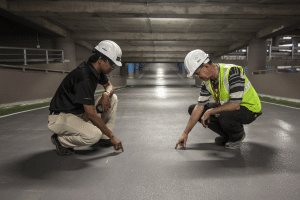August 2016 Newsletter – OSHA silica rules
Many employers may not yet fully appreciate the impact of the new OSHA silica standards, but it is important they do because most will have to make significant changes to their operations to comply.
The new OSHA silica standards considerably tighten exposure limits, require employers to take steps to protect workers, and impose requirements to offer medical exams and conduct training. Fortunately, employers have a model to work from in that the approach that OSHA has taken is very similar to its asbestos, arsenic and lead standards, although construction companies are allowed more flexibility in how they comply.
A little later in this article, we’ll outline six key steps that employers must take to meet the standards, but first a little background.
There are actually two new OSHA standards, one for construction, and one for general industry and maritime. Both became effective June 23, although employers are being given time to comply: by June 23, 2017, for construction, and a year later for general industry and maritime.
OSHA established these new standards because it believes that its previous exposure standards were inadequate, and that there are hundreds of thousands of U.S. workers exposed to hazardous concentrations of respirable crystalline silica, causing hundreds of deaths and thousands of silica-related diseases, such as silicosis and lung cancer, every year.
Exposures in construction can occur during common tasks, such as using masonry saws, grinders, drills, jackhammers and handheld powered chipping tools; operating vehicle-mounted drilling rigs; milling; operating crushing machines; and using heavy equipment for demolition or certain other tasks. Work activities in industries such as concrete products, stone cutting, asphalt roofing, foundries, ready mix concrete, support activities for oil and gas operations, and shipyards, also may also pose a hazard.
Both OSHA silica standards require employers to take specific steps for employees exposed above the action limit of 25 μg/m3 (micrograms of silica per cubic meter of air), averaged over an 8-hour day. Additional steps are required of employers whose workers are exposed above the permissible exposure limit (PEL) of 50 μg/m3, averaged over an 8-hour day.
Key steps
Key steps employers must take:
- Establish and implement a written exposure control plan that identifies tasks that involve exposure and methods used to protect workers. In addition, the construction standard requires employers to designate a competent person to implement the written exposure control plan.
- Measure the amount of silica that workers are exposed to if it may be at or above an action limit. However, if employers in the construction industry choose to implement the hazard controls specified in Table 1 of the construction standard for their typical work tasks, they do not have to measure their employee exposures.
- Protect workers from respirable silica exposures above the PEL by using dust control or respiratory protection when dust controls cannot limit exposures to below the PEL.
- Offer medical exams, including chest X-rays and lung function tests, every three years for workers in general industry and maritime exposed at or above the action limit for 30 or more days per year, or when required to wear a respirator for 30 or more days in the construction industry.
- Train workers on work operations that result in silica exposure, and on ways to limit exposure.
- Keep records of workers’ silica exposure and medical exams.
Craig Beck is a senior advisor at FDRsafety, specializing in occupational health/industrial hygiene, and advises employers on complying with OSHA silica standards. Contact him at info@fdrsafety.com or 1-888-755-8010.
FDRsafety named one of Top 5 safety consultants
FDRsafety is proud to have been named one of the Top 5 safety-only consulting companies in the country by Business Insurance magazine.
Business Insurance compiles the rankings each year for firms that have 100 percent of their revenue derived from safety consulting.
“This ranking is reflects the expertise and dedication of the FDRsafety team,” said Fred Rine, founder and CEO of FDRsafety.
“Employers across the country, large and small, have come to rely on FDRsafety to provide top-notch services, from providing on-site safety professionals to fill project needs, to expert witnesses, OSHA consulting, and our unique safety awareness program, which changes employee attitudes towards safety and builds safety cultures.”
We’re now offering specialized on-line training
FDRsafety has expanded its range of training offerings by offering on-line training to supplement our extensive roster of instructor-led, on-site training programs.
On-line training allows employers to provide specialized training to individuals or groups on specific technical topics in areas ranging from industrial hygiene, to trenching, confined spaces and more.
More information is available here.
